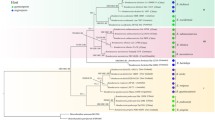Abstract
Based on a comparative phylogenetic analysis of Goloviomyces and their host tribes of the Asteraceae, we speculate that Golovinomyces first acquired parasitism to the Asteraceae after migration of the family into the Northern Hemisphere and before the divergence of the tribe Carduaeae. The divergence time of the Carduaeae is estimated to be 25.2 Myr ago based on the molecular clock of rbcL sequences of the Asteraceae. When 25.2 Myr is given at the node of the first split of the phylogenetic tree of Golovinomyces, nucleotide substitution rates of the Erysiphales are calculated to be 2.52 × 10−9 per site per year (0.01D = 3.97 Myr) in the ITS region and 6.5 × 10−10 per site per year (0.01D = 15.4 Myr) in the D1 and D2 regions of the 28S rDNA.
Similar content being viewed by others
Author information
Authors and Affiliations
Corresponding author
About this article
Cite this article
Takamatsu, S., Matsuda, S. Estimation of molecular clocks for ITS and 28S rDNA in Erysiphales. Mycoscience 45, 340–344 (2004). https://doi.org/10.1007/s10267-004-0187-7
Received:
Accepted:
Issue Date:
DOI: https://doi.org/10.1007/s10267-004-0187-7




